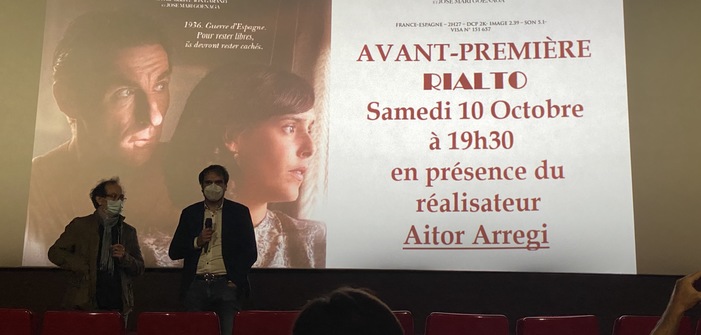Spanish director Aitor Arregi was present at the Rialto to present his new feature film. Co-directed with Jon Garaño and Jose Mari Goenaga, A Secret Life takes place in post-civil war Spain (1936). We follow the lives of Rosa and Higinio. The latter is forced to hide in his own home to escape the Francoist government. The protagonist is torn between love and the fear of reprisals. The film will be released in France on October 28, and a review will be dedicated to it on the site at that time.
How would you describe your film?
When we told this story, we knew it was a very good story for cinema. The film deals with the figure of the mole, the one who hides. It was very present in the imagination and reality of the Spanish in the 1950s. It’s also a figure that provokes debate and some discomfort. Taking all these elements into account, we thought it was relevant for the big screen. This story allowed us to tackle two universal stories beyond just the story of this mole figure. These two themes are, firstly, the fear of changing the situation and secondly, love within a couple, which is going to go through this entire period.
What would happen to the moles if they went out during the Francoist period?
The first years following the end of the civil war are extremely harsh, and obviously, for the moles, being discovered meant death. For those living in Andalusia, the topography of this region was even more unfavorable for escape. It could have been different in the Basque Country. However, some moles were close to France. This spark of hope was a sign to run. We don’t know much about the number of people who came out of hiding after the amnesty. No census was done, but we speak of a range of 200 or 300 individuals. There’s a case where, despite the amnesty, a man remained locked up for 8 more years.
You often play with light and its presence. What is its importance?
Indeed, an evolution in the film in terms of lighting is perceptible. The beginning of the film corresponds to a manhunt and extreme danger. The second part is more of a thriller, so the lighting had to match this atmosphere. Then, little by little, the film enters a new narrative phase. The story spans thirty years. The lighting had to evolve with the unfolding of the scenario. Light serves to emphasize these different stages.
Is the story you tell a true story or an assembly of different accounts?
Higinio Blanco did not exist, what we did is a fiction that is fed by reality while using elements from various stories of different people. Among all moles, the woman is their pillar. Since obviously none of them could have survived without this presence. This figure allows the film to be placed within the theme of the couple but also to emphasize the fear of coming out. For those who ask, the women locked away were extremely weak. However, we consider that they were reclusive themselves in this hole.
What would you have done in the place of the moles?
I think I don’t know what I would have done. I haven’t experienced anything similar to be able to answer you. The tension between the figure of the hero and that of the coward is interesting from a narrative point of view. I have the impression (not necessarily in relation to the film) that a mirror is placed in front of my face, asking me “What would you have done?” This discomfort seems stimulating from a cinematic point of view. And as a person, it allows me to learn about the unease that history produces as an individual.
In recent years we’ve seen films about this Francoist period. Is Spain working on its history?
I regret not sharing this opinion. There should be many more films, books, on the civil war and the Francoist dictatorship. And unfortunately, Spain has not seized the theme as it should have. […] It saddens me because we should be able to consider today that it is impossible for a dictator to be buried in a mausoleum as if he were a hero.


